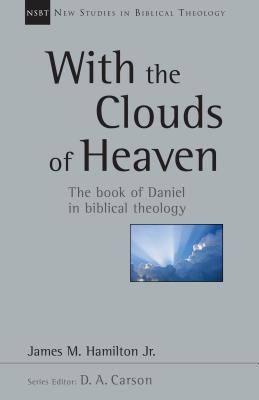
Editor’s Note: To supplement Kathy Cooper’s Daniel: Notes for Grad Bible Studies, a review of With the Clouds of Heaven by James M. Hamilton, Jr. Thank-you to Bob Trube for sharing his reviews with Emerging Scholars! Bob first posted the above review on Bob on Books. ~ Thomas B. Grosh IV, Associate Director, Emerging Scholars Network . . .
With the Clouds of Heaven (New Studies in Biblical Theology) by James M. Hamilton, Jr. Downers Grove, IL: InterVarsity Press, 2014.
Summary: A true study of the biblical theology of Daniel, including its structure, key themes, how the book influences both early Jewish literature and the New Testament, and how it connects to key themes throughout scripture.
In this book, James M. Hamilton, Jr. sets out to give us an evangelical biblical theology of the book of Daniel. He begins by assuming a canonical approach to the book of Daniel, that Daniel would have had access to most of the works that preceded his, and he contends, against a significant part of the scholarly community for dating Daniel in the exile, and not in the Maccabean period of the second century B.C.
Working from these assumptions then, Hamilton sets out first to consider Daniel’s contribution to the Old Testament picture of the history and future of the world, which is one that reflects the literary structure of exile and return, with the critical piece of the four kingdoms, the coming of the Son of Man, and the end of days including the 70 weeks. He considers the visions of Daniel 2-4, 7-8, and 10-12 and their meaning, the beastly powers that attempt to stamp out the people of God against which the faithful are to stand in hope. He then discusses the seventy weeks, with the persecution of the faithful and the ultimate victory of the son of man. With that he turns to the various heavenly figures throughout Daniel and considers which may be equated with the son of man, and actually determines that none can be definitively equated with him.
Chapters 7 to 9 then explore how the book of Daniel influenced early Jewish literature, the New Testament other than Revelation, and finally the use of and fulfillment of Daniel in Revelation. Hamilton argues that not only the language but also the structure of Revelation parallels that of Daniel.
I thought the final chapter the most interesting as Hamilton considers Daniel as part of the big story of all of scripture, considering the parallels of Daniel with Joseph in Egypt, Nehemiah, Esther, Jehoiachin, and finally Jesus. Daniel’s life is a type as intercessor, one who “rises from the dead” and his message with the four kingdoms, during the last of which the kingdom of the son of man comes, in the sixty ninth week, as it were. Hamilton sees the seventieth week as divided into the first half, a long period of growth and witness, and a final tribulation the last three and a half days (a shorter time he argues) before the final victory of the son of man and the resurrection of the dead.
Whether or not one agrees with all of Hamilton’s conclusions, what is most valuable in this book is the careful work in the structure and theology of Daniel, the appropriation of Daniel in later literature, and the place of Daniel within the canon of Scripture. Furthermore, Hamilton draws out Daniel’s vision of history that is of great encouragement to faithfulness as kingdom advance is met with beastly resistance and brutal opposition. Daniel’s faithful witness and prophetic word call us to a faithful witness that looks one way or the other to the Lord for deliverance from the lion’s mouth, and for the final restoration of all things.
This is a wonderful resource for the student of scripture who wants to understand more deeply the inter-textual connections between Daniel and the rest of scripture. It is a valuable resource to those who would teach or preach this book and a good complement to any commentary in understanding the “big picture” of Daniel.
Bob Trube is a former Associate Director of Faculty Ministry and Director of the Emerging Scholars Network. He blogs on books regularly at bobonbooks.com. He resides in Columbus, Ohio, with Marilyn and enjoys reading, gardening, choral singing, and plein air painting.

Leave a Reply